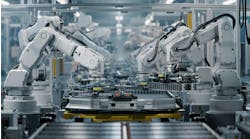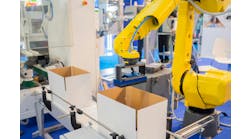Applied Manufacturing Technologies (AMT), one of North America’s largest independent automation engineering companies supporting manufacturers, robot companies, systems integrators and line builders, promoted Craig Salvalaggio to the position of company president. As he took the helm, he answered three questions about the future of system integration.
Salvalaggio has been a part of AMT for more than 20 years, most recently as chief operating officer (COO) before taking the reins as president. In 2017, as vice president of engineering, he wrote an article about automation that was published in Control Design.
“Promoting Craig to the role of president was an easy decision,” said AMT’s founder and CEO Michael Jacobs. “His passion for AMT and his remarkable leadership skills as COO over the past three years have been integral to our success. Craig has built an incredibly dedicated team, and his unwavering commitment to our company, culture and values inspires the AMT team. I am certain that Craig will continue to lead AMT to even greater heights in his new role as president.”
Salvalaggio’s promotion to president is a well-deserved recognition of his exceptional leadership skills, said Louis Finazzo, a long-time acquaintance and vice president of sales for Fanuc America. Applied Manufacturing Technologies has received the Sales Growth Award at the Fanuc Authorized System Integrator (ASI) Conference four times since 2015. “He is an industry pioneer and a very strong and capable leader, with remarkable situational awareness and interpersonal skills,” noted Finazzo. “Under his leadership, AMT has achieved great success, earning the prestigious FANUC Level V Integrator award and becoming a trusted strategic partner. Craig’s dedication to his customers and his team has been critical to the company’s growth and reputation, and I have no doubt that he will continue to excel in his new role.”
Since becoming COO, Salvalaggio has led overall operations of AMT, along with sales, engineering and talent management. His technical skills in automation and robotics combined with his leadership ability led to his current role. Salvalaggio’s strategic mission is to continue driving growth and diversity of both the systems and services market segments at AMT.
With a bachelor of science degree in mechanical engineering from Lake Superior State University in Sault Ste. Marie, Michigan, Salvalaggio also holds a master of science in operations management and an MBA from Kettering University in Flint, Michigan.
Salvalaggio is actively involved in the Association for Advancing Automation (A3) on the Robotics Tech Sector board of directors.
Founded in 1989, AMT specializes in automated end-of-line equipment, material-handling systems and engineering support globally, employing more than 120 experienced and controls and automation engineers with more than 1,250 combined years of experience engaged in automation projects across an array of industries. From its headquarters in Orion, Michigan, AMT reports it has engineered more than 25,000 automation systems worldwide on 5,500 projects for more than 600 customers.
How do you foresee system integration evolving for material-handling and end-of-line applications?
Salvalaggio: As the world of manufacturing continues to see a shortage of factory workers and fewer early-career professionals inclined to enter manual-labor-based jobs, we will see an increase in the demand for automation of material-handling applications. This, coupled with lifting heavy loads for long periods of time, ensures that robots are a good fit for that task. Integrators have access to new technology for vision-based picking systems, along with pallet movement through automated guided vehicles (AGVs) and autonomous mobile robots (AMRs).
How will robotic integration continue to alter the factory floor, and who will be responsible for ensuring the interoperability of robots from different manufacturers?
Salvalaggio: There has been several attempts to look at the systems-integration world with agnostic interfaces, where all devices are interoperable with original-equipment-manufacturer (OEM) based interfaces. All manufacturing of robotic and automation technology has focused on easy-to-use interfaces with easier setup, lead-through teach programming and interfacing ability. We will see a big shift on common platforms in the next five years.
In what way is after-sales service and support being impacted by the ability to monitor equipment remotely, and how is AMT leveraging sensing technology for condition monitoring?
Salvalaggio: As a system integrator, you need to be able to respond fast in a down-production scenario. Having remote connectivity, troubleshooting, and access provides that option to get the systems back into production. With technology and the ability to collect data, sensor information and overall-equipment-effectiveness (OEE) metrics, you can ensure we are looking at it from a proactive standpoint to monitor our systems and ensure customer satisfaction.





